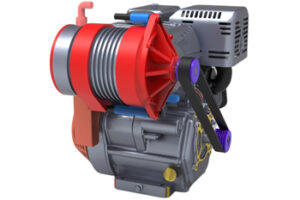 Hybrid Belt Generators
Hybrid Belt Generators
Larger power belt driven generators are more in demand as electrical power requirements increase for industrial mobile equipment. Storing this power in battery banks allows OEMs to offer ancillary electrical equipment or hybridize existing equipment without major design overhauls.
Traditionally, belt starter generators have been lower voltage (12 and 24V Belt Generators) and low power (1 to 2 kW Belt Starter Generators). These generators were also meant to be run intermittently for short periods of time under full load conditions.
View more of our product portfolio for DC alternators.
Belt Driven Generators for more than ‘mild hybrids’
The push to hybridize mobile equipment has led to higher voltage and high power belt driven generators. 48V belt driven generators can now be sized to 100 Amps, 200 Amps and 300 Amps (48V – 5kW, 10 kW and 15 kW Belt Generators). This gives OEM designers the option of having large electrical power availability.
Other common voltages for Belt Starter Generators
- 24 V Belt Starter Generators
- 48 V Belt Starter Generators
- 72 V Belt Starter Generators
- 240 V Belt Starter Generators
- 400 V Belt Starter Generators
Integrating into engine assemblies requires flexibility. Traditional belt driven units have had small diameters for small amounts of power. Finding the space within existing canopies can be challenging. Innotec Power can offer belt driven DC alternators in longer rotor designs or as a single larger diameter.
More background information on Belt Driven DC Alternators is below.
Belt-driven generators are used to harness rotational power supply and convert this to electrical energy. This rotational power could be received from an engine.
The working principle behind generators is called Faraday’s law of electromagnetic induction which states that when a conductor, moving in a magnetic field, cuts magnetic lines of force, an EMF (electromagnetic force) is induced in the conductor. The rate of change of flux is responsible for determining the induced EMF. This induced EMF is responsible for the flow of electric current in a closed circuit.
Since most devices are incorporating more and more electronic components, meeting the energy demand has become a major concern. This is where a belt-driven generator comes into play.
OEMs – Industrial Requirement
OEMs are constantly looking for efficient energy production to meet the increasing demand for electric energy supply to power various electronics. Belt-driven generators are an excellent solution to meet the on-site demand for electricity. Also, they can easily replace the conventional alternators, without requiring many changes to be accommodated.
An important use of belt-driven generators is in mild hybrid systems in automobiles. In mild hybrid systems, the belt-driven generator stores energy (ie. in a 48 V battery pack), which then supplies the energy when required. The power starts/stops the engine, provides excess torque to the crankshaft in certain driving situations, etc. The belt-driven generators also serve as energy recuperation systems, wherein they recapture energy during braking or deceleration, and transfer this energy to the battery.
Also, since the environmental effect of gas-powered vehicles has also become a major concern, mild hybrid systems help in the reduction of CO2 emissions. They reduce engine idling times at traffic stops. The technology is called BSG (Belt-driven starter generator). Where a conventional starter requires energy from the battery to power up the engine via a starter motor, BSG acts as a bi-directional alternator, powering the engine during start-up. After starting up, the engine drives the generator to produce electrical energy, which is stored in a battery.
Although both alternator and generator serve a similar purpose of converting rotational or mechanical energy into electrical energy, the alternator has a limitation that it can only generate AC, whereas the generator can produce both AC and DC.
